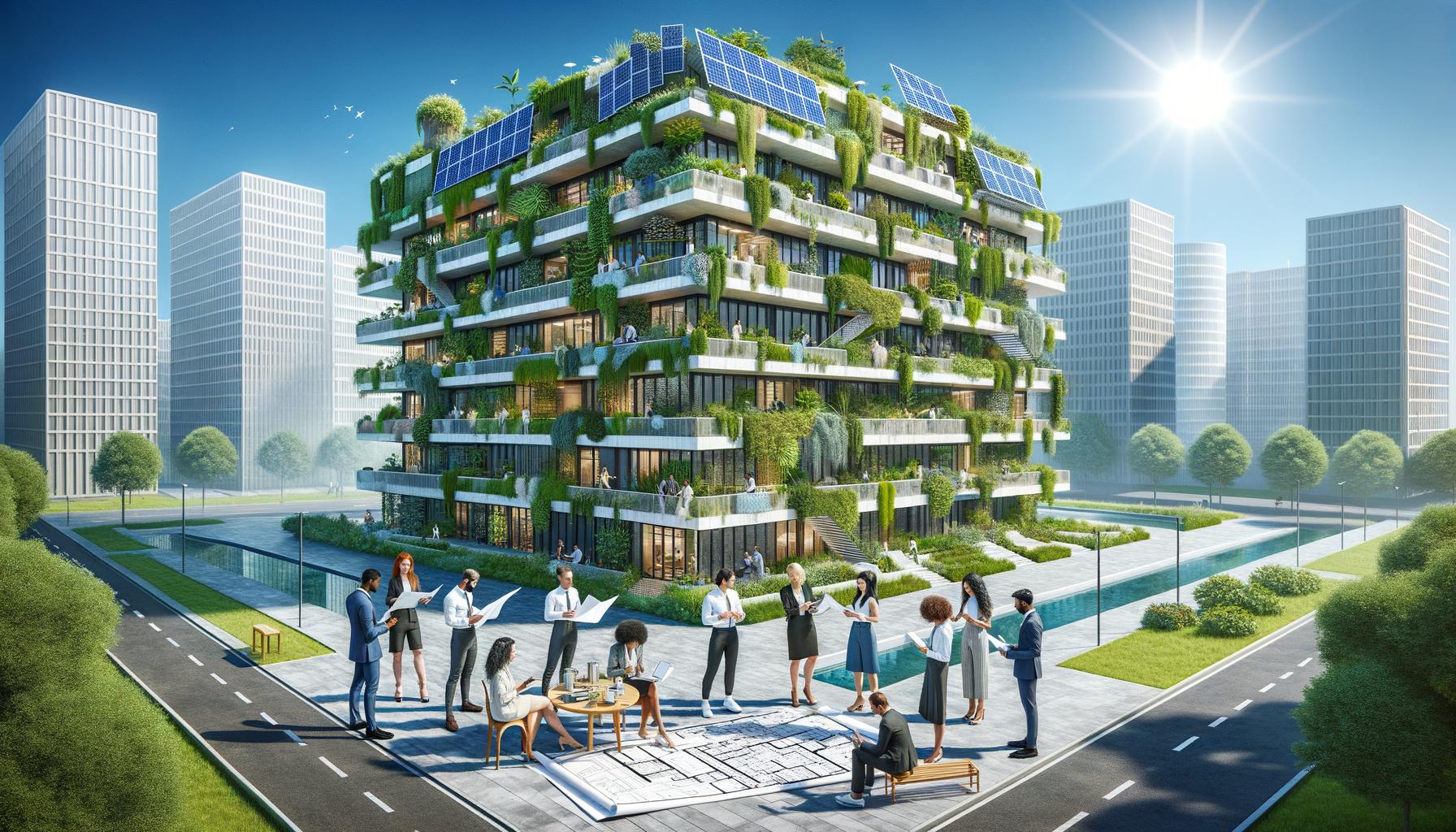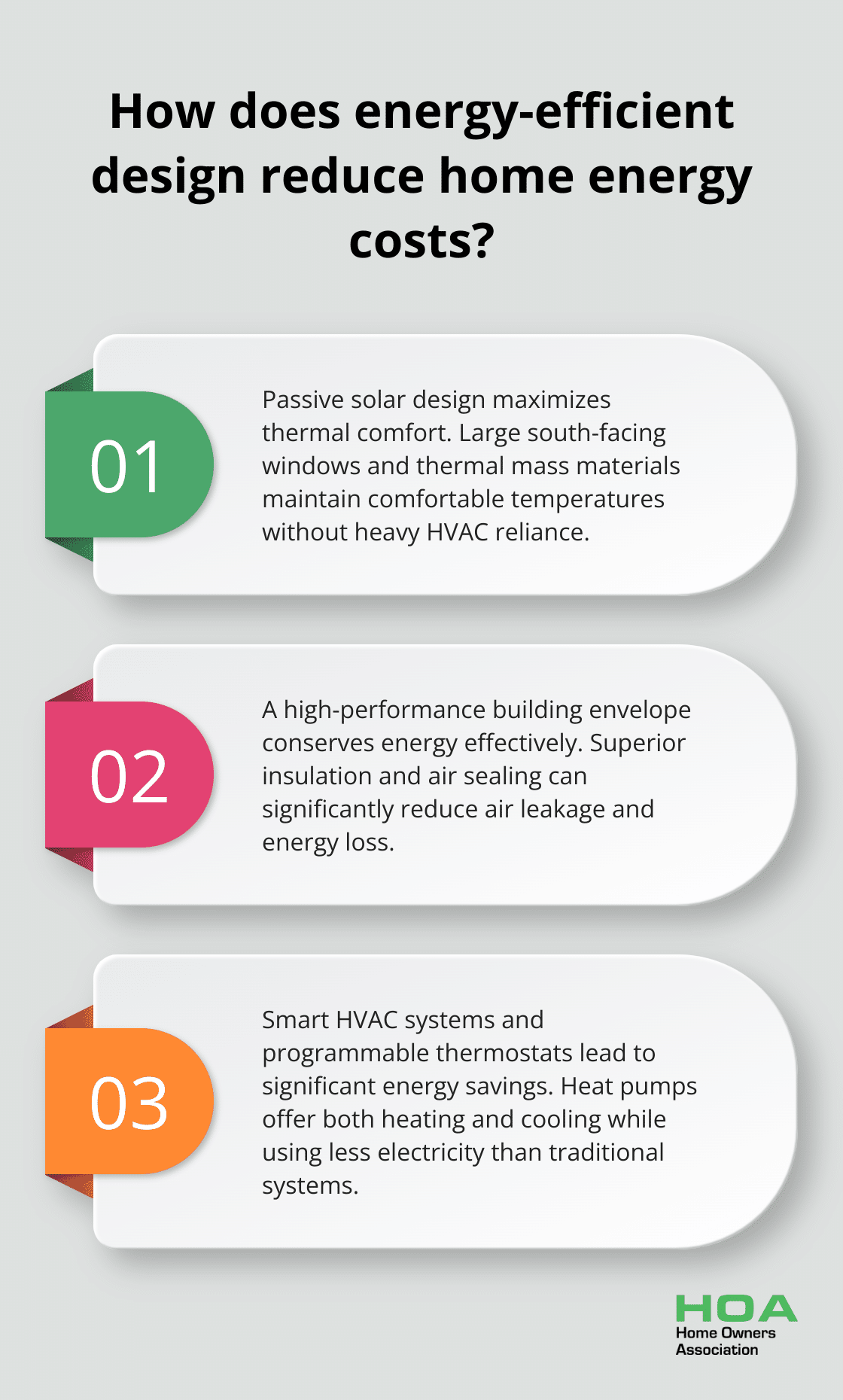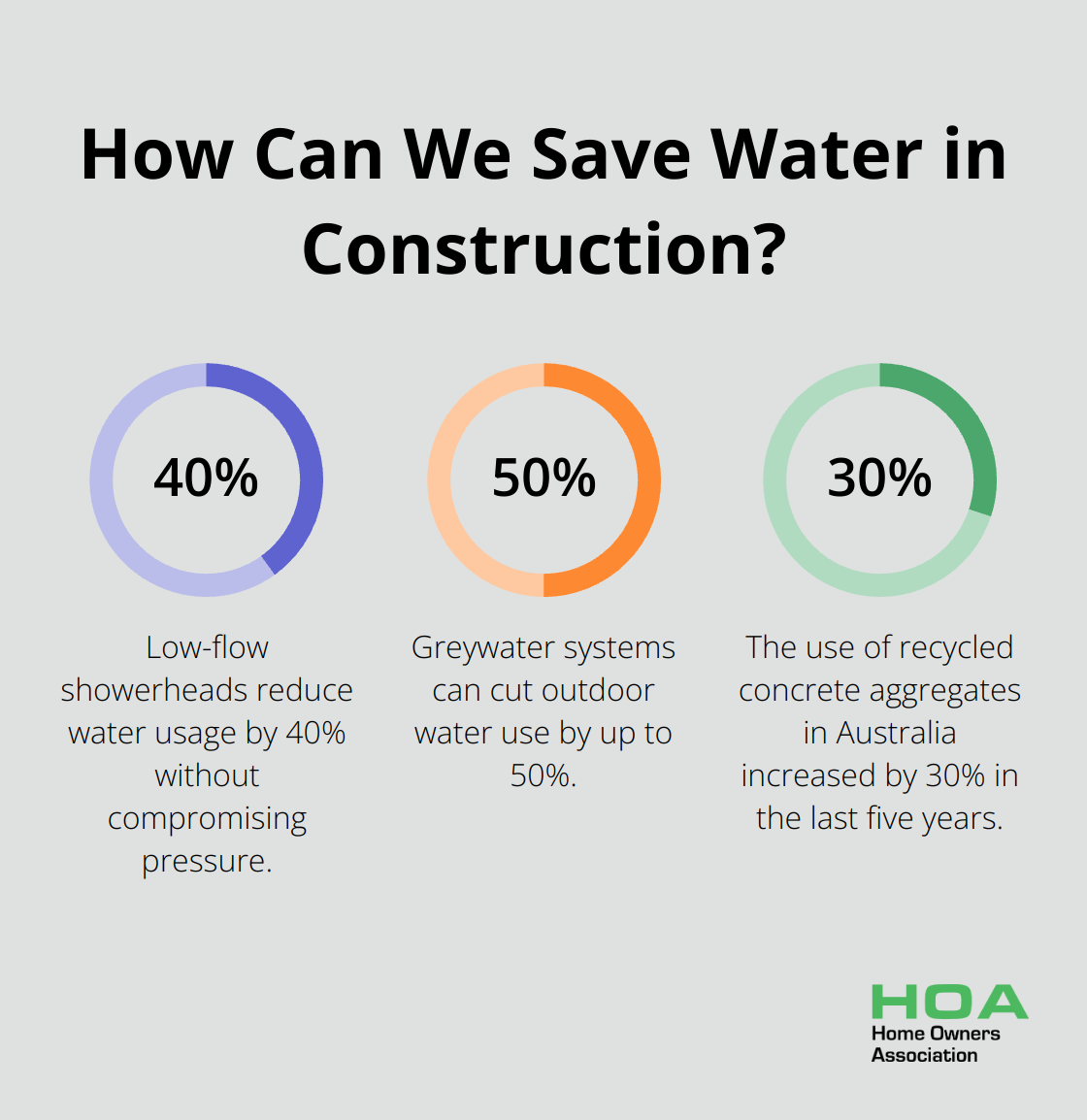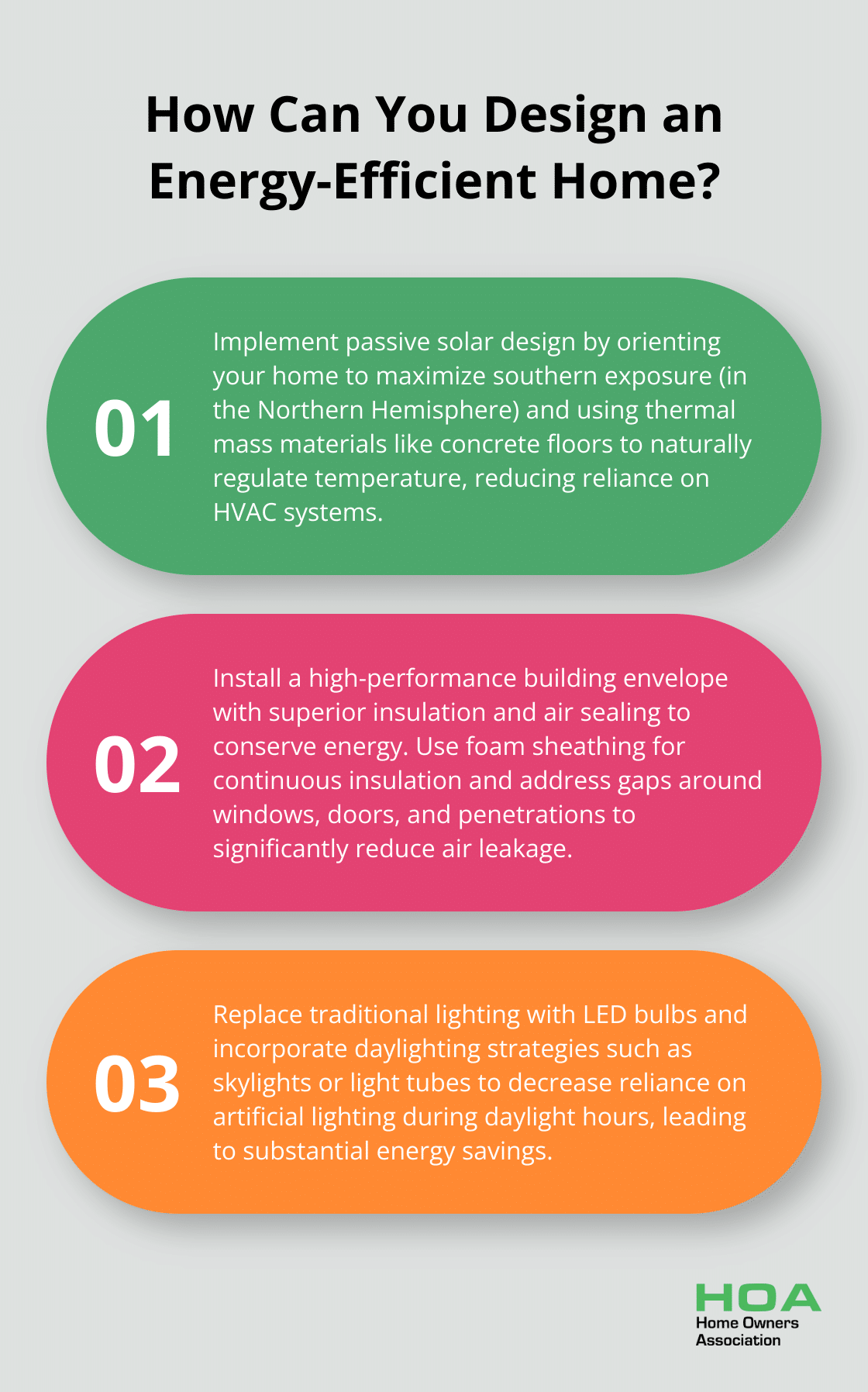
At Home Owners Association, we’re excited to explore sustainable building practices that can transform our communities. These innovative approaches not only reduce environmental impact but also lead to significant cost savings for homeowners.
In this post, we’ll break down the best sustainable building practices, from energy-efficient design to cutting-edge green technologies. Get ready to discover how you can create a more eco-friendly and efficient home while contributing to a greener future.
How Energy-Efficient Design Cuts Costs
At Home Owners Association, we witness the dramatic impact of energy-efficient design and construction on homeowners’ utility bills and comfort levels. Let’s explore practical strategies that deliver real results.
The Sun’s Power in Home Design
Passive solar design transforms energy efficiency. These design principles utilize aspects to maximize thermal comfort by using the climate and local environment. Orienting buildings to maximize southern exposure in the Northern Hemisphere (or northern exposure in Australia) naturally heats homes in winter and reduces cooling needs in summer. Large, south-facing windows paired with thermal mass materials (like concrete floors or brick walls) absorb heat during the day and release it at night, maintaining comfortable temperatures without heavy reliance on HVAC systems.
The Importance of a Tight Building Envelope
A high-performance building envelope conserves energy effectively. This involves superior insulation, such as foam sheathing, which provides a continuous layer of insulation. This reduces thermal bridging through wood studs, saving energy and improving comfort. Air sealing is equally vital – addressing gaps around windows, doors, and penetrations can reduce air leakage significantly.
HVAC Efficiency Optimization
Smart HVAC systems revolutionize home climate control. Programmable thermostats can lead to significant savings on energy costs. For even greater savings, zoned systems allow different temperature settings for various areas of your home. Heat pumps offer both heating and cooling capabilities while using less electricity than traditional electric heating systems.
Smart Lighting for Illumination and Savings
LED lighting reduces energy consumption simply yet effectively. These bulbs use less energy and last longer than incandescent lighting. The combination of LEDs with daylighting strategies (such as skylights or light tubes) significantly decreases reliance on artificial lighting during daylight hours.

The implementation of these energy-efficient strategies leads to substantial long-term savings. While the initial investment may be higher, the payback period often ranges from 5 to 10 years, depending on the specific measures implemented.
As we move forward, let’s explore how sustainable building practices further enhance the eco-friendliness and efficiency of our homes.
Sustainable Materials for Eco-Friendly Homes
At Home Owners Association, we observe a significant shift towards sustainable building design. This trend benefits the environment, improves indoor air quality, and reduces long-term maintenance costs.
Recycled and Local Materials: A Smart Choice
The use of recycled and locally-sourced materials transforms sustainable building. Recycled steel production requires up to 10 times less energy than producing steel from virgin iron ore. Local materials, such as stone or timber, cut transportation emissions and bolster regional economies. In Australia, the use of recycled concrete aggregates increased by 30% in the last five years, which significantly reduced landfill waste.
Healthier Homes with Low-VOC Products
Volatile Organic Compounds (VOCs) in paints and finishes can harm indoor air quality. Low-VOC alternatives now match traditional products in performance and variety. When selecting paints, adhesives, sealants, and carpets, look for products that meet the ‘Total VOC Limits’ stipulated by green building standards. When you select paints, try to find those with VOC levels below 50 grams per liter for optimal air quality.
Sustainable Timber and Alternatives
The Forest Stewardship Council (FSC) certifies sustainable timber, which ensures responsible forest management. Bamboo, a rapidly renewable resource, grows 30 times faster than traditional hardwoods and is 25% harder than red oak. For outdoor applications, composite decking (made from recycled plastics and wood fibers) offers durability with minimal maintenance.
Water Conservation: Every Drop Matters
Water-efficient fixtures play a vital role in Australia’s often drought-prone climate. Dual-flush toilets save up to 67% more water compared to standard models. Low-flow showerheads reduce water usage by 40% without compromising pressure. Greywater systems, which recycle water from sinks and showers for irrigation, can cut outdoor water use by up to 50%.

The implementation of these sustainable building practices contributes to environmental conservation and results in tangible benefits for homeowners. From improved air quality to reduced utility bills, the advantages are clear. As we move forward, let’s explore green technologies and renewable energy solutions that further enhance home efficiency and sustainability.
Powering Homes with Green Tech
At Home Owners Association, we observe a surge in homeowners who embrace green technologies and renewable energy solutions. These innovations reduce environmental impact and lead to significant long-term cost savings.
Solar Power Revolution
Solar panel integration has become more accessible and affordable. In Australia, a commonly sized 6kW Solar PV System would cost between $4,000 and $6,000 in most states, while a 10kW system would cost between $8,000 and $10,000. This covers a significant portion of a household’s energy needs and potentially leads to substantial savings on electricity bills.
Geothermal Heating and Cooling
Geothermal systems use the earth’s constant underground temperature to heat and cool homes efficiently. These systems reduce heating and cooling energy consumption by up to 70% (although they are less common in Australia due to higher installation costs). The Australian Geothermal Energy Association reports that a properly sized residential system can last 25 years for inside components and 50+ years for the ground loop.
Living Architecture
Green roofs and living walls gain popularity in urban areas. These features improve insulation, absorb rainwater, and reduce the urban heat island effect. A study by the University of Technology Sydney found that green roofs can reduce cooling energy needs by up to 13% in summer. Installation costs typically range from $150 to $400 per square meter.
Smart Home Energy Management
Smart home automation systems revolutionize energy management. These systems can help you manage and reduce your energy consumption through intelligent control of lighting, heating, and appliances. Popular features include:
- Occupancy sensors that adjust lighting and temperature automatically
- Smart thermostats that learn household routines and optimize HVAC usage
- Energy monitoring systems that provide real-time consumption data

Smart home technology brings the convenience of product control right to your fingertips, potentially leading to significant energy savings.
These green technologies require careful planning and often a significant upfront investment. However, the long-term benefits in energy savings and increased property value make them worthwhile considerations for many homeowners. As technology advances and costs continue to decrease, we expect to see even wider adoption of these sustainable solutions across Australia.
Final Thoughts
Sustainable building practices empower homeowners to reduce their environmental impact while reaping significant long-term benefits. These practices encompass energy-efficient design, sustainable materials, and cutting-edge green technologies. The implementation of passive solar design, high-performance building envelopes, and smart HVAC systems dramatically reduces energy consumption and utility costs.

Recycled and locally-sourced materials, along with low-VOC products, minimize environmental impact and create healthier living spaces. Water conservation fixtures and systems play a vital role in preserving our precious water resources. The integration of renewable energy solutions (such as solar panels and geothermal systems) combined with smart home automation further enhances the efficiency and sustainability of modern homes.
We at Home Owners Association encourage our members to incorporate sustainable building practices into their future projects. The initial investment in these technologies and materials often pays off through reduced operating costs, improved comfort, and increased property value. As the importance of sustainable building practices grows, homeowners who embrace these innovative approaches create residences that are comfortable, efficient, responsible, and forward-thinking.





